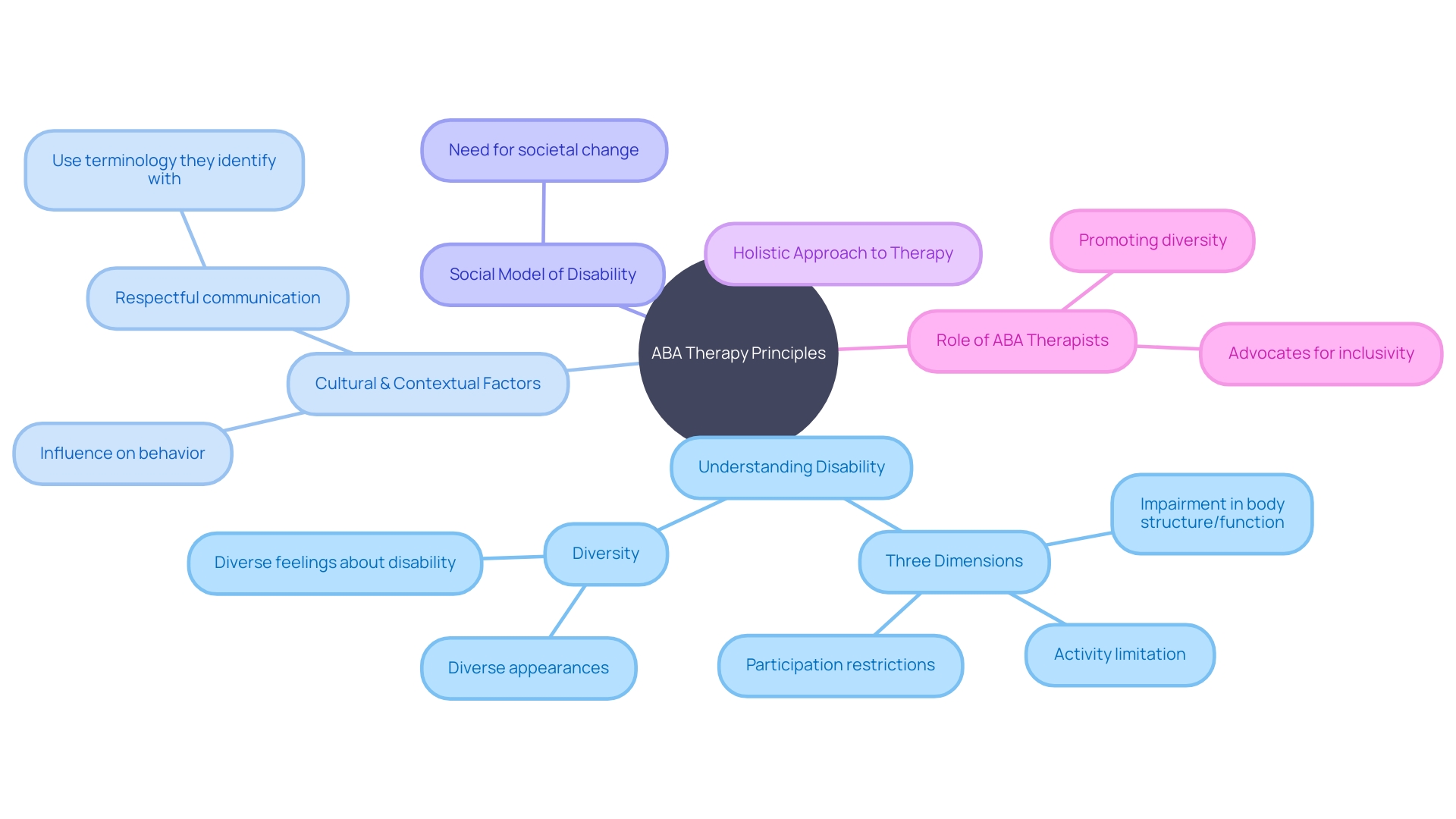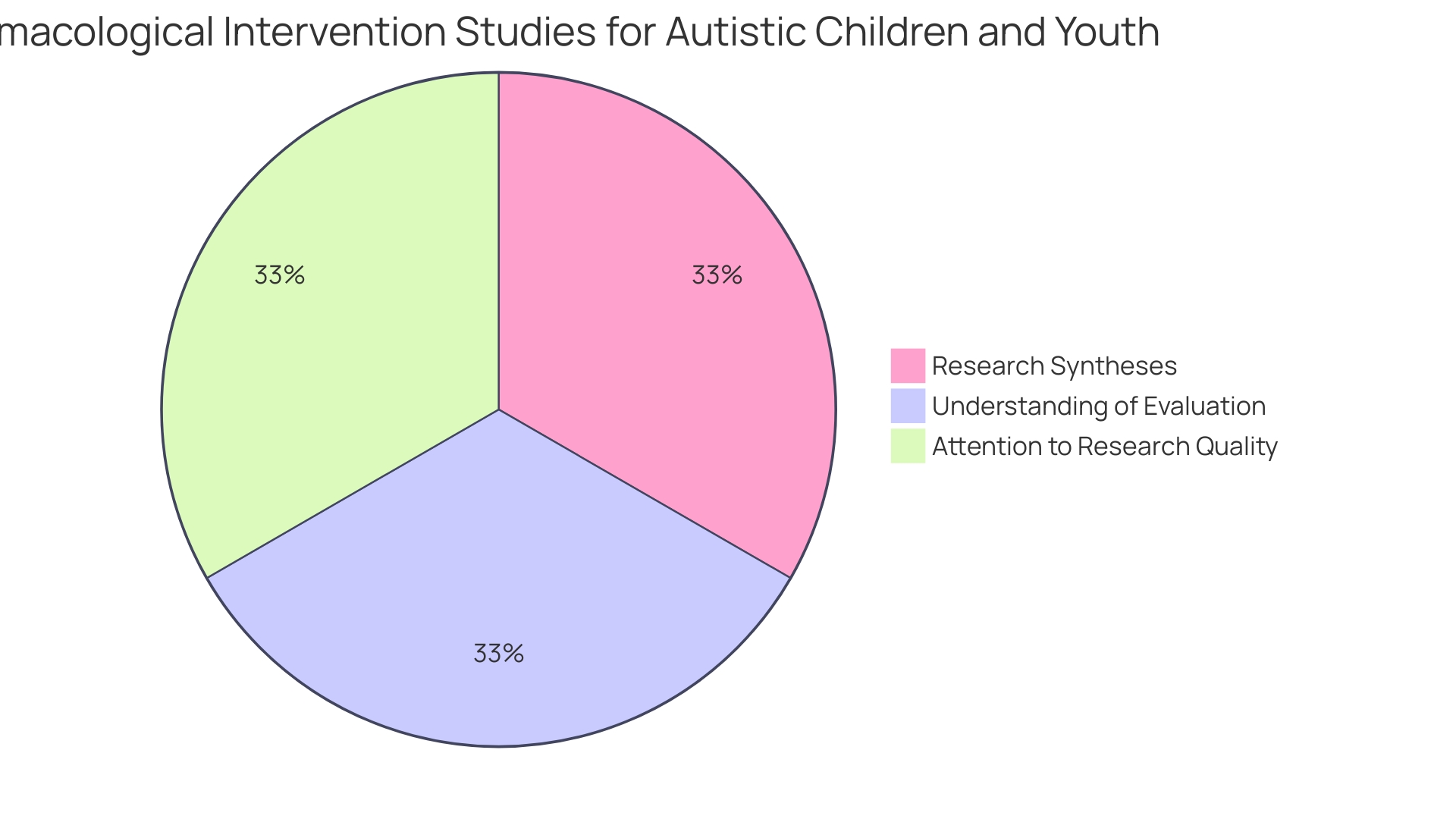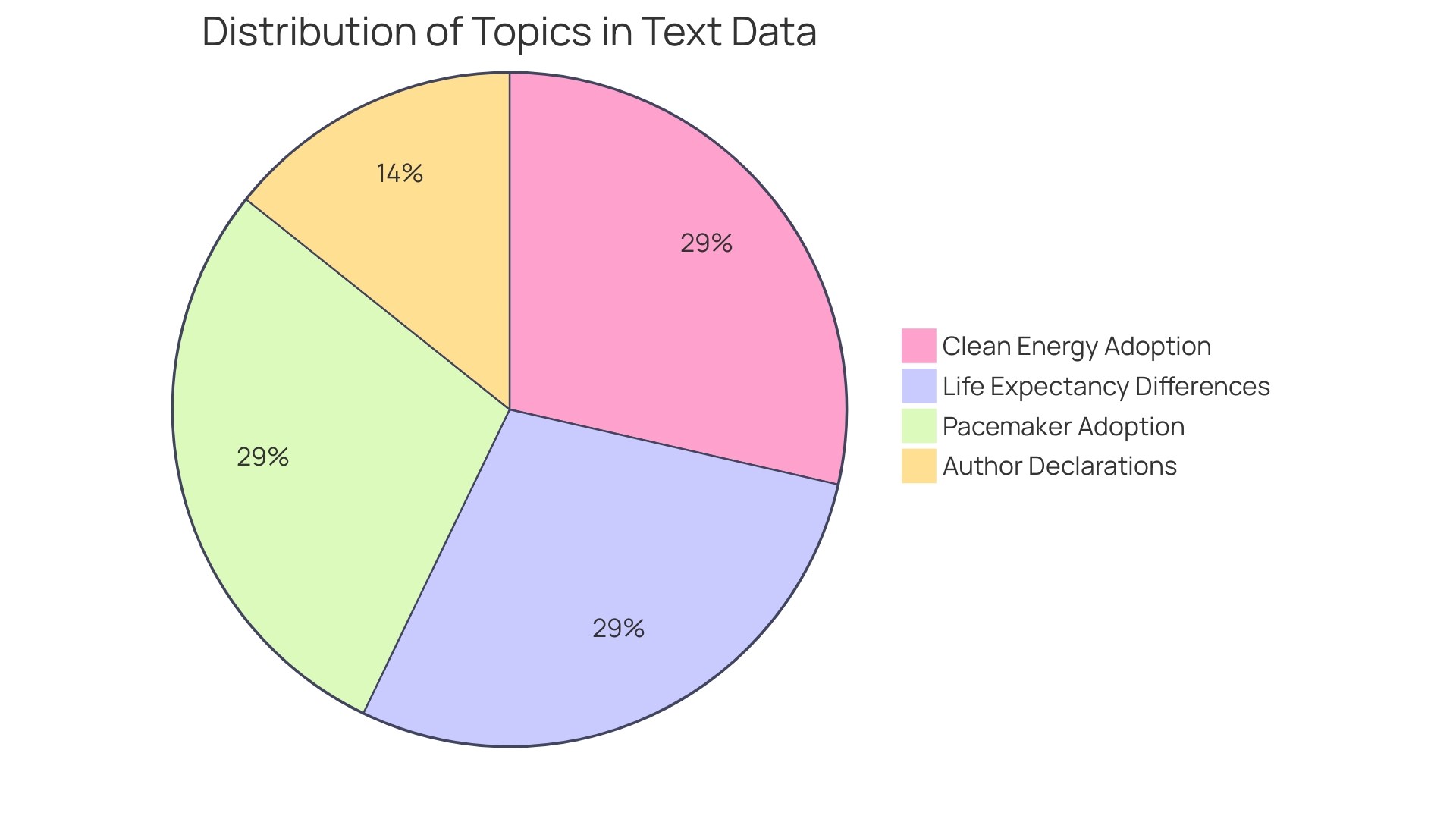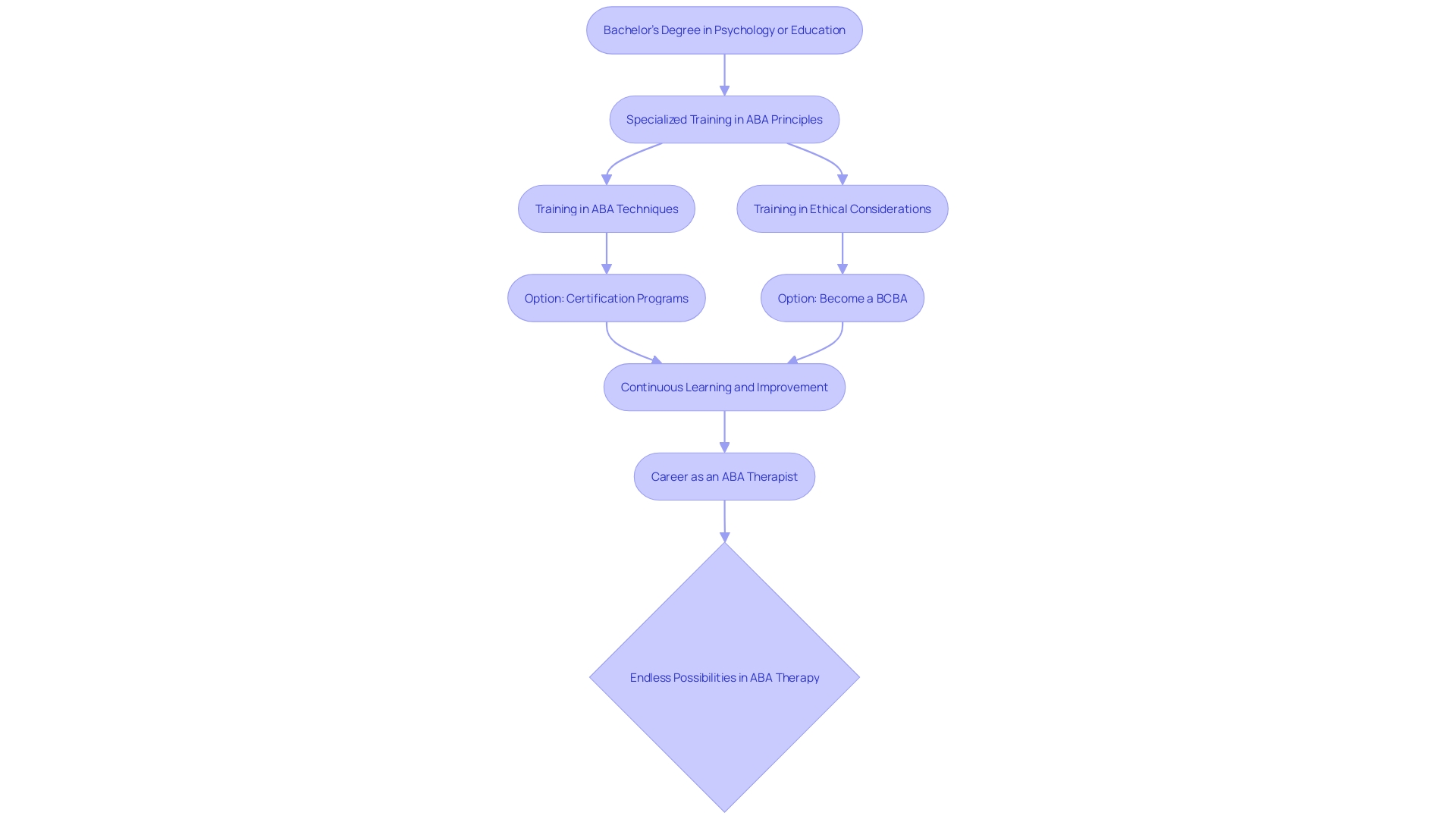Introduction
ABA Therapists, skilled in Applied Behavior Analysis, play a vital role in supporting individuals with autism and developmental disorders. Their expertise lies in creating tailored therapy plans to enhance behavior, communication, social skills, and overall quality of life. With the understanding that autism is a diverse spectrum, ABA therapy moves beyond a one-size-fits-all approach to address the individual needs of each person.
As the demand for ABA professionals continues to rise, driven by increasing autism diagnoses and an aging population, innovative work models are emerging. The latest ABA Practice Guidelines emphasize the importance of quality treatment that adapts to the unique strengths and challenges of those on the autism spectrum. ABA therapy is not just a clinical practice; it is a commitment to empowering individuals with autism and ensuring they receive personalized care that respects their identity and enhances their well-being.
What is an ABA Therapist?
ABA Therapists, skilled in Applied Behavior Analysis, are dedicated professionals who serve as an invaluable resource for individuals with autism and developmental disorders. Their expertise lies in crafting tailored therapy plans to enhance behavior, communication, social skills, and life quality. The evolving definition of autism, as highlighted by Dr. Jan Blacher, emphasizes the need for adaptable interventions. Today's practice of ABA therapy acknowledges the diverse intellectual and communicative abilities among individuals with autism, moving beyond a one-size-fits-all approach to address the spectrum's breadth.
As the field continues to grow, driven by rising autism diagnoses and an aging population, the demand for ABA professionals escalates. In fact, by 2032, an estimated 25.2% of the U.S. population will be 65 or older, which is anticipated to surge the need for health and personal care services, including those skilled in ABA. These trends are shaping the job landscape and pushing for innovative work models, such as the flexible hybrid approach introduced by the Center for Autism and Related Disorders, to attract top talent in ABA therapy.
The most recent ABA Practice Guidelines from the Council of Autism Service Providers reinforce the importance of quality in ABA treatment, ensuring it adapts to the individual needs of those on the autism spectrum. As the social model of disability suggests, this approach recognizes autism as a facet of social identity and injustice, requiring personalized, respectful support. This modern interpretation of ABA therapy is not just a clinical practice but a commitment to enhancing the lives of individuals with autism and ensuring they receive care that acknowledges their unique strengths and challenges.
Key Responsibilities of an ABA Therapist
ABA Therapists are vital in the field of behavioral health, especially given the recent evolution in understanding autism spectrum disorders. With autism now identified in 1 in 36 individuals, the diversity in the spectrum calls for tailored and high-quality interventions, as emphasized by the new ABA Practice Guidelines released by the Council of Autism Service Providers. ABA Therapists must adapt to the growing needs by engaging in continuous professional development, embodying flexibility in their work models, and fostering strong, trust-based relationships with the families they serve. These responsibilities are underscored by the shift towards recognizing disability through the social model, which views disability as a social construct and encourages practices that support autistic individuals in a more inclusive, culturally sensitive manner. ABA Therapists are tasked with the implementation of evidence-based practices and ethical principles, embracing the complexity of human behavior to promote learning and positive behavior change across all ages and abilities.
Client Assessment and Individualized Treatment Plans
A Board Certified Behavior Analyst (BCBA) initiates ABA therapy by conducting a comprehensive evaluation, identifying both the strengths to build upon and the areas that need support. With a focus on unique individual requirements, a tailored treatment plan is devised, detailing specific, measurable objectives to be pursued. This plan serves as a dynamic blueprint, adapting over time as progress is regularly monitored, ensuring the child's continual development. The treatment plan is not only about the child; it encompasses the entire family's needs, recognizing the importance of flexible scheduling to integrate seamlessly into their lives. This approach aligns with Dr. David (Dan) R. Offord's vision of a fair race for every child, including those with disabilities, by addressing their needs and leveraging their strengths to foster mental health and well-being. In line with the latest ABA Practice Guidelines, quality implementation is paramount to achieving effective outcomes. The flexibility of the treatment model also reflects the evolving nature of professional roles within the ABA field, where a balance between work commitments and personal life is increasingly sought after.
Implementing Behavior Interventions
ABA Therapy, a practice deeply rooted in evidence-based strategies, is not merely about addressing challenging behaviors but about understanding the unique cultural and contextual factors that influence an individual's behavior. ABA therapists are trained to implement interventions with nuanced consideration for the individual's environment and personal identity. Drawing from the new guidelines released by the Council of Autism Service Providers, therapists are now encouraged to facilitate stronger alliances between schools, families, and healthcare providers to create a supportive network around the individual.
Guided by the social model of disability, ABA therapy acknowledges disability as a societal construct, emphasizing the importance of societal change alongside personal growth. This perspective is critical because, as highlighted in recent research, the majority of intervention studies have failed to address the potential harm of not considering the social and cultural context of the individuals being treated. Effective therapy must move beyond the outdated medical model, which views disability as a deficit, and embrace a holistic approach that respects the individual as a whole person.
The recent news from AT-Newswire Press Release News Distribution Service reinforces the need for accessible and trustworthy platforms to disseminate information on the latest ABA therapy practices, ensuring that both professionals and the community stay informed about the evolving standards of care. In line with this, ABA therapists are adopting flexible, hybrid models of work to cater to the diverse needs and lifestyles of their clients, as well as their own. This adaptability not only enhances the quality of care but also attracts and retains top talent within the field.
Statistics indicate that while ABA therapy can produce significant improvements, such as the 30-point IQ gains reported by Ole Ivar Lovaas, there is also a pressing need to critically evaluate the ethics and effectiveness of interventions. It is crucial to consider whether the behaviors targeted for change are genuinely harmful or merely deviations from 'normality' that could lead to burnout or mental health issues in individuals with autism.
In sum, ABA therapists are not just behavior change agents; they are advocates for a more inclusive society that values diversity and individuality. By integrating the principles of the social model of disability and acknowledging the cultural dimensions of treatment, therapists are paving the way for a more respectful and effective practice that champions the rights and identities of those they support.

Collaboration and Communication with Families and Professionals
A Board Certified Behavior Analyst (BCBA) begins by conducting a thorough assessment to understand the unique needs of a child. With this in-depth knowledge, they work collaboratively with families to establish tailored, measurable goals for the child's progress. The key to effective ABA therapy lies in the BCBA's commitment to consistent monitoring and adjustment of strategies, ensuring the child's continued development. Flexibility in scheduling and services is crucial, as every family's situation is distinct, with its own set of challenges and strengths.
Active communication and the establishment of trust with parents and caregivers are paramount. By practicing active listening and clear communication, BCBAs convey their dedication to the child's well-being and their respect for the family's insights and capabilities. This partnership empowers parents, giving them confidence in their role in their child's growth and reinforcing that their contributions are both valued and essential.
The BCBA also extends their collaborative efforts to include other professionals involved in the child's care, fostering a holistic approach. This coordinated effort ensures that every aspect of the child's and family's needs are addressed, from educational and behavioral to social and emotional. The integration of the social model of disability within ABA therapy emphasizes the importance of societal change alongside individual support, advocating for equity and inclusion in all areas of life.
Granpeesheh's hybrid model of work illustrates the industry's movement towards flexibility, not just in therapy sessions, but in the professional environment, enhancing the ability to attract and retain skilled BCBAs. Furthermore, partnerships like that of Aetna Better Health of Kentucky and MapHabit underscore the significance of ongoing communication between care teams and members, and the comprehensive coordination of care across various needs and limitations.
The rise in autism diagnoses, as noted by Dr. Jan Blacher, reflects a broader understanding of the spectrum, prompting the need for diverse and adaptable therapeutic approaches. With the goal of making the race fair for all children, as Dr. David (Dan) R. Offord emphasized, the focus is on supporting the child's participation in all life domains, reducing stress, and ensuring that caregivers have the necessary resources for the child's and family's well-being. This vision aligns with the therapy's objectives, striving for a society where every child can thrive.
Data Collection and Analysis
ABA therapy involves meticulous documentation by therapists to track an individual's development and reaction to interventions. By recording each session, therapists assess the efficacy of the therapy plan, observe behavioral patterns, and steer therapy towards more successful outcomes. This rigorous data collection is essential, given the complexity of behaviors in individuals with autism, where up to 80% may exhibit aggressive behaviors. These can include self-injury, tantrums, and aggression toward others, creating substantial challenges for families and professionals alike.
The recent release of the third edition of the Applied Behavior Analysis (ABA) Practice Guidelines by the Council of Autism Service Providers underscores the importance of high-quality, standardized care to effectively treat autism. This is a significant development in the field, considering that research has indicated flaws in intervention studies for autism, making it crucial to understand their impacts comprehensively.
Moreover, the challenges in accurately diagnosing autism, as evidenced by the variability in the Modified Checklist for Autism in Toddlers-Revised with Follow-Up (M-CHAT-R/F) results in different settings, highlight the need for objective and scalable tools for early intervention. Such tools would help in mitigating the disparities in access to diagnosis and treatment, especially in the face of societal and cultural inequalities.
The data-driven approach in ABA therapy is not just about improving individual outcomes but also about addressing broader systemic issues. Understanding that disability is a social construct, as suggested by the social model of disability, can shift the focus from the individual's 'deficits' to societal barriers, paving the way for more inclusive practices and reducing discrimination.
In conclusion, ABA therapists' commitment to data-driven strategies is integral for enhancing the quality of life for individuals with autism and their families, and the ongoing advancements in guidelines and screening tools are vital steps towards more equitable and effective care.

The Importance of Positive Reinforcement in ABA
ABA therapy, a practice centered on applied behavior analysis, leverages positive reinforcement as a cornerstone technique. By acknowledging and rewarding desired behaviors with affirmations, tangible rewards, or new privileges, therapists can significantly boost the motivation of individuals. This approach not only fosters the acquisition of new skills and the formation of beneficial habits but also amplifies engagement in therapeutic activities. For instance, in 2008, a French child receiving ABA therapy exhibited behaviors such as head-banging, which not only posed a risk to themselves but also presented challenges for caregivers. Through consistent positive reinforcement, the therapy aimed to recalibrate the child's interaction with their environment, potentially easing the path to social acceptance.
These principles of positive reinforcement are supported by the latest ABA Practice Guidelines from CASP, emphasizing correct and high-quality implementation. Dr. Mary Barbera, a prominent figure in the ABA community, highlights the versatility of these strategies across a spectrum of autism presentations, addressing behaviors from stimming to aggression, while also considering the emotional and financial aspects of autism.
As the understanding of autism evolves, with current estimates suggesting 1 in 36 individuals are affected, the relevance of ABA therapy remains significant. A historic case illustrated the dramatic impact of intensive ABA therapy, where children achieved marked improvements in IQ and adaptive behaviors. In today's context, ABA is often considered the 'gold standard' for autism treatment, drawing on a rich history of research and a dedication to enhancing the lives of individuals on the spectrum.
Settings and Flexibility of ABA Therapy
Applied Behavior Analysis (ABA) therapy, recognized for its effectiveness in autism treatment, is a versatile intervention adaptable to various environments. This flexibility ensures that ABA therapists can tailor their approaches to meet the unique needs of individuals across settings such as homes, schools, clinical spaces, or community programs. With a growing population of individuals diagnosed with autism—now estimated at 1 in 36, according to Dr. Jan Blacher from UC Riverside—the demand for such tailored interventions has never been greater.
The diversity of autism presentations, which can range from nonverbal individuals to those with high IQs and some communicative abilities, necessitates ABA therapy that is both dynamic and responsive. Dr. Blacher's insights underscore the importance of evolving ABA practices to accommodate the broad spectrum of autism. This evolution aligns with the social model of disability, which views disability through the lens of social constructs and emphasizes adapting environments and attitudes to support individuals with disabilities.
Moreover, the Council of Autism Service Providers recently updated their ABA Practice Guidelines, emphasizing the need for high-quality implementation. These guidelines serve as a standard of care for various stakeholders, indicating the critical role of ABA in autism treatment. The flexibility of ABA therapy, as demonstrated by the Center for Autism and Related Disorders' shift towards a more adaptable work model for BCBAs, reflects the ongoing commitment to attracting the right talent and providing the highest quality of care.
In this context, ABA therapists are not only clinicians but also strategic partners, working closely with families to build rapport and trust. The collaborative approach emphasizes clear communication and active listening, as highlighted by industry leaders, to ensure the child's best interests are at the forefront of therapy. As the field of ABA continues to grow and adapt, the focus remains steadfast on meeting the individual needs of each person, fostering learning and development in the most supportive and effective ways possible.

Qualifications and Training for ABA Therapists
Pursuing a career as an ABA Therapist involves a blend of formal education and hands-on training. Typically, a bachelor's degree in a relevant discipline such as psychology or education is the foundation. Beyond the degree, specialized training in ABA's guiding principles, techniques, and ethical considerations is paramount. This training equips professionals to apply ABA therapy effectively, addressing the unique needs of individuals with autism spectrum disorder (ASD).
Recent advancements underscore the dynamic nature of the field. Notably, the Council of Autism Service Providers has released updated ABA Practice Guidelines, reflecting the latest standards of care and emphasizing the importance of quality implementation. These guidelines serve as a beacon for professionals to align their practices with the highest standards. The new guidelines highlight the necessity for therapists to remain abreast of evolving practices and to adapt their methods accordingly.
Moreover, the social model of disability informs ABA practices by stressing disability as a social construct, suggesting that the environment and societal attitudes significantly shape the experience of disability. This perspective encourages ABA Therapists to consider broader contextual factors when supporting autistic individuals and to advocate for social justice within their practice.
As ABA Therapists advance in their careers, many opt for certification programs or aim to become board-certified behavior analysts (BCBAs). This additional credentialing reflects a commitment to excellence and a dedication to meeting the complex needs of those they serve. It's a testament to the therapist's expertise and a promise of adherence to the field's ethical standards.
The role of ABA Therapists is crucial, as they often form the bridge between research and real-world application, ensuring individuals with ASD receive the most effective support possible. With the field ever-evolving, these professionals must commit to continuous learning and improvement to provide the highest quality care.

The Impact and Effectiveness of ABA Therapy
Applied Behavior Analysis (ABA) therapy is a potent tool in fostering positive behavior changes and skill development in individuals with autism and ADHD. The transformative role of ABA therapy is highlighted by the fact that autistic children and youth often face significant challenges in engaging with their environment, which can lead to a high risk of social exclusion. By focusing on individual needs and reducing stress, ABA therapists empower these individuals to participate more fully in school, home, and community life, advancing mental health and equity.
The effectiveness of ABA therapy is underlined by research which emphasizes the importance of high-quality implementation. According to the Council of Autism Service Providers, the therapy is most beneficial when applied correctly, ensuring that each individual's unique needs are met. This is more crucial than ever, as autism diagnoses have increased, pointing to a diverse spectrum where individuals exhibit a range of abilities and challenges.
Recent advancements in understanding autism's neurodevelopmental aspects have shed light on the necessity for nuanced intervention approaches. For instance, studies by Professor Kenkichi Takase and Professor Eiichi Nojiri have delved into the complexities of the brain's functionality, which can be particularly enlightening when considering ABA therapy's applications.
Moreover, the nascent guidelines provided by CASP for ABA therapy serve as a roadmap to ensure that individuals with autism receive care that is tailored to their specific needs. This is echoed by the experiences of practitioners who have recognized the value of flexible and adaptive approaches to ABA therapy, which not only benefit the recipients but also enhance the work-life balance of therapists.
The impact of ABA therapy is further substantiated by its potential to address co-occurring conditions, such as irritability and hyperactivity, commonly found in autistic children. Parents have reported significant improvements in their children's behaviors when interventions are carefully selected and professionally administered. It is the dedicated work of ABA therapists that turns research and guidelines into real-world benefits, making a profound difference in the lives of individuals with autism and their families.
Conclusion
In conclusion, ABA Therapists are invaluable in supporting individuals with autism and developmental disorders. Their expertise in creating tailored therapy plans enhances behavior, communication, social skills, and overall quality of life. ABA therapy goes beyond a one-size-fits-all approach, adapting to the unique needs of each person on the autism spectrum.
With the increasing demand for ABA professionals driven by rising autism diagnoses and an aging population, innovative work models like the flexible hybrid approach are emerging. The latest ABA Practice Guidelines emphasize the importance of quality treatment that respects the individual needs of those on the autism spectrum.
ABA Therapists play a vital role in behavioral health, adapting to evolving needs through continuous professional development, flexible work models, and strong relationships with families. They conduct comprehensive evaluations and devise tailored treatment plans that adapt over time, taking into account the entire family's needs.
Collaboration with families and other professionals is crucial, ensuring a holistic approach to care. Meticulous data collection drives effective therapy, monitoring progress and enhancing outcomes for individuals with autism and their families.
ABA therapy is versatile, adaptable to various environments such as homes, schools, and community programs. Pursuing a career as an ABA Therapist requires formal education, specialized training, and a commitment to continuous learning.
In conclusion, ABA Therapists empower individuals with autism, providing personalized care that enhances their well-being and promotes their participation in all aspects of life. Their vital role in promoting inclusivity and supporting individuals with autism is backed by research and the importance of high-quality implementation. ABA therapy has the potential to make a profound difference in the lives of individuals with autism and their families, fostering positive behavior changes and skill development.




